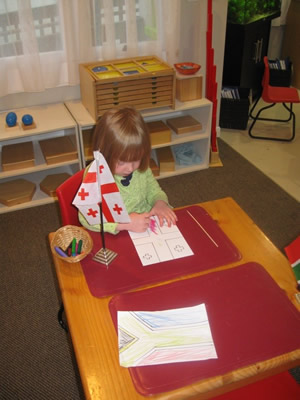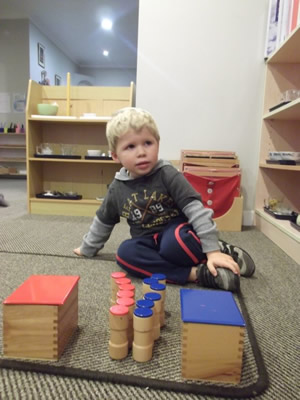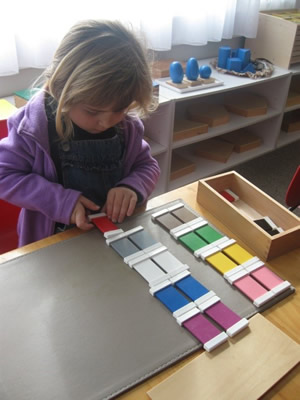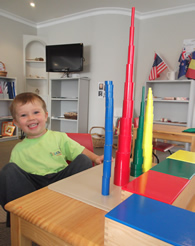The Prepared Environment
There are three factors influencing a child in the Montessori
classroom – environment, teacher and teaching materials.
In traditional schools the teacher often takes centre
stage imparting knowledge through her resources and expecting
children
to learn from her in a group situation. This arrangement
limits the scope of children’s learning as it is
mainly undertaken in the abstract and children do not control
the
amount of repetition.
In the Montessori classroom the environment is dominated
by the interaction between the children and materials and
not by the teacher. The teacher’s role is to maintain
this environment and to supervise the children; s/he needs
to make sure that the materials are set out in a specific
order and that they are complete and tidy as the children
will be learning through the environment.
Dr Montessori believed that a reliable, consistent and
uncluttered environment helps children to organise their
mental and physical
development. In a classroom where things are reliable children
can go about their activities freely without having to
ask for items or wait for the teacher’s permission.
The atmosphere in a Montessori classroom is purposeful
and productive
without the need for constant interaction between the child
and the teacher.
 
A predictable and orderly environment also fosters children’s
independence and self-confidence. Children will always know
where to find a specific activity they are interested in;
they are free to choose any activity and have the freedom
to spend as long as they like doing it and to repeat it as
many times as they wish. It is obvious how some of the activities
from the Practical Life area such as dressing frames help
the child to become more self-confident through acquiring
new skills. The aim of other materials such as Pink Tower – an
early mathematics activity, can be more indirect. The freedom
of choice in a Montessori classroom is the consequence of
a carefully laid out environment in which all choices are
good in a sense that they all offer children the opportunity
to challenge, refine or acquire a new skill depending on
their interests.

Montessori
saw that children went through a specific period during
a morning’s work when they appeared restless
and seemingly ill at ease. Rather than interfere, however,
she let the children carry on. What became apparent was that
this period was critical as a build up to the higher level
work that was to follow. The ‘false fatigue’ as
she called it, allowed the child to prepare themself
in their own time. Children who were allowed to complete
full cycles
of work seemed to demonstrate the need for periods of
calm reflection on the tasks that they had accomplished.
It appeared
that the natural work cycle of a child that had begun
to concentrate was about three to four hours and the
more that
a child was able to complete their own work cycles, the
happier, more self-disciplined and self-motivated he
became. A lengthy
work cycle is beneficial to spontaneous activity and
independent learning; it also guarantees the freedom
of repetition.
The teaching materials designed by Montessori are divided
into groups. These consist of Practical Life, Sensorial,
Literacy, Mathematics, and cultural materials such as History,
Biology and Geography.
|

